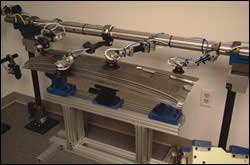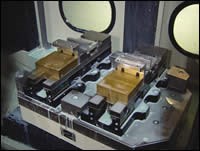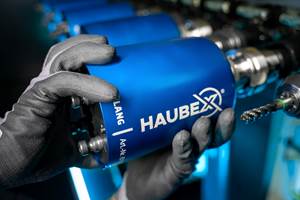Vises Facilitate Swift Change-Overs, Reduce Errors
Syron Engineering & Manufacturing is a 28-year-old company specializing in the design and manufacture of tooling and sensors for industrial automation. One of the company's main fields of activity is the development of equipment to transfer sheet metal from one press operation to the next, primarily for automotive stamping.
Share




Syron Engineering & Manufacturing (Saline, Michigan) is a 28-year-old company specializing in the design and manufacture of tooling and sensors for industrial automation. One of the company’s main fields of activity is the development of equipment to transfer sheet metal from one press operation to the next, primarily for automotive stamping.
In this context, Josh Jeffers, programmer and shop supervisor at Syron, explains that finding ever-faster ways to move these parts is one of the company’s ongoing challenges.
“As soon as we are able to speed things, then we are already looking at ways to go even faster,” he says.
At Syron, all steps of design, manufacturing, assembly and testing are carried out in-house. The tooling systems that the company develops consist of a combination of custom parts and standard components. Pressure to produce a variety of components faster led the company’s manufacturing team to re-examine its processes.
Management provided the staff with a copy of Shigeo Shingo’s book A Revolution In Manufacturing: The SMED System, at which point employees started to evaluate the machine downtime caused by setups. It soon became apparent that there was a considerable amount of idle spindle time associated with part change-overs for milling operations. Following the SMED principles, Syron conducted methodical time studies, analyzing the entire process to determine which steps could be converted from internal to external setup.
The bulk of the company’s milling is done on two OKK VP-400 two-pallet VMCs. Prior to implementing SMED, a typical setup required about 3 hours, or 183 minutes to be exact. One setup consisted of retrieval, assembly, installation and justification of each tool’s length; removal and replacement of jaws for the next job; installation and adjustment of workstops; and edge-finding to determine the work coordinates. During this time, the spindle was idle.
The company says that it employs a pool of 17 basic tools for most of its parts. These tools are now left on the machine at all times, reducing tool setup time to virtually zero. The remaining job-specific tools are assembled and pre-set externally. In addition, tool lengths are put into the program by the presetter. Now, internal tool setup consists of replacing a few tools in the machine’s tool changer in a few minutes.
“Our analysis of the workholding setup indicated that a completely different type of workholding system was needed to support external setup,” Mr. Jeffers explains.
As a result, Syron selected a system of locator plates and twin vises from Bock Workholding (Ford City, Pennsylvania) that allowed it to use external fixturing. The fixturing is placed on the machine to obtain a constant positioning repeatability that is relative to the machine’s coordinates without the need for program adjustments.
The workholding system consists of four basic elements: locator plates, which are designed to offer an accurate pattern of locating and mounting holes identified by a letter and a number; a DexLoc locator pin, which is a double-expanding pin that allows vise positioning on the locator plate with a repeatability of ±0.0005 inch; twin vises, which serve as the carrier for the fixtures and have matching mounting and locating holes; and quick-change, snap-on jaws. The vises contain the clamping mechanism, and the jaw carriers and have accurate locators for the center jaw. The quick-change, snap-on jaws are machined to include all necessary stops and hold a part in an exact position. The jaws are stored away from the machining centers in coded boxes containing a raw and finished sample part.
The combination of these elements allowed Syron to convert all but a fraction of the workholding setup to external setup. Jason Beerens, tooling manager at Syron, does much of this work.
“When a new job comes up, we preset the tools, put them into a cart and adjust the program accordingly,” Mr. Beerens explains. “We then retrieve the jaws and place them in the cart with the sample parts, and it gets moved to the machine. All that is left to do is snap off the outbound jaws; clean; snap the new ones into predetermined locations on the twin vises; and then place the new tooling in predetermined positions in the changer, call up the program and go.”
Each vise holds two parts using three jaws—one fixed central jaw containing all of the locating surfaces and two movable jaws. “The fixed jaw is attached to the Twin Vise with two bolts, and the movable jaws are held from below the vise bed. This allows for ample room to machine even deep pockets” explains Joe Cousins, president of Bock Workholding. At Syron, the jaws are typically configured to the first operation on one side of the fixed jaw and the second operation on the other side of the fixed jaw. After these changes were implemented, the Syron team analyzed the new SMED implementation. The company says that the results are convincing: Typical change-over has diminished from 3 hours to 30 minutes, while spindle time is maximized. Syron also reports fewer operator errors and less scrap as benefits of making the switch.
Related Content
Cutting Part Programming Times Through AI
CAM Assist cuts repetition from part programming — early users say it cuts tribal knowledge and could be a useful tool for training new programmers.
Read More3 Ways Artificial Intelligence Will Revolutionize Machine Shops
AI will become a tool to increase productivity in the same way that robotics has.
Read MoreSame Headcount, Double the Sales: Successful Job Shop Automation
Doubling sales requires more than just robots. Pro Products’ staff works in tandem with robots, performing inspection and other value-added activities.
Read MoreUsing the Toolchanger to Automate Production
Taking advantage of a feature that’s already on the machine tool, Lang’s Haubex system uses the toolchanger to move and store parts, making it an easy-to-use and cost-effective automation solution.
Read MoreRead Next
Building Out a Foundation for Student Machinists
Autodesk and Haas have teamed up to produce an introductory course for students that covers the basics of CAD, CAM and CNC while providing them with a portfolio part.
Read More5 Rules of Thumb for Buying CNC Machine Tools
Use these tips to carefully plan your machine tool purchases and to avoid regretting your decision later.
Read MoreRegistration Now Open for the Precision Machining Technology Show (PMTS) 2025
The precision machining industry’s premier event returns to Cleveland, OH, April 1-3.
Read More












%20and%20Josh%20Jeffers.jpg;width=700;quality=80)
























